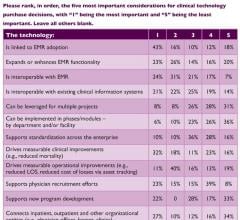If you enjoy this content, please share it with a colleague
Philips
RELATED CONTENT
Elekta, Royal Philips and University Medical Center (UMC) Utrecht (the Netherlands) announced that the initial components of the world's first high-field magnetic resonance imaging (MRI) guided radiation therapy system are being installed at UMC Utrecht.
Today’s digital picture archiving and communication systems (PACS) is highlighted with several choice words around the industry: accessible, flexible, Web-based, thin client versus thick client and vendor-neutral. Whatever term is used to describe the PACS of today and the future, one thing is clear: the aim now is to be able to store medical images, sourced from any modality, in a secure location on a network and retrieve them for review from any platform or any device.
As a less expensive, radiation-free form of medical imaging, ultrasound is finding increased utility in many areas of healthcare. The technology’s evolving flexibility and portability make it an attractive option for doctors looking to triage patients in an emergency room, perform rapid cardiology examinations or offer supplemental imaging for women who have already undergone screening mammograms. Its use is rapidly expanding at the point of care in hospitals in more than 20 specialties, according to a December 2013 report in the journal of the World Heart Federation, Global Heart.1
Mobile C-arms have become a popular option in many operating rooms (ORs) across the nation as healthcare organizations look to save space and money. According to Klaus Hörndler, managing director of Ziehm Imaging, “ORs in hospitals are becoming ever smaller, while more devices are being used inside them.” Because mobile C-arms are smaller, lighter and more easily maneuvered than fixed angiography systems, they provided an effective solution. At a fraction of the cost of fixed angiography, these systems are also a good option for budget-conscious facilities that have limited financial resources or are experiencing budget cuts.
Criticism and confusion notwithstanding regarding the appropriateness of X-ray mammography as the gold standard in breast screening, digital mammography will continue to provide an important cog in the wheel of breast care pathways. The United States, some may say, is a slowing market for the digital mammography imaging modality due to a gradual decrease in the number of breast imaging facilities, reduction in replacement rates of mammography units and the possible linkage of reduced procedure numbers to the 2009 U.S. Preventive Services Task Force (USPSTF) recommendations.
Interoperability, mobile connectivity and technologies that drive real-time actionable information at the point of care will be the focus of health information technology (IT) investments in 2014. This is according to the results of a new healthcare leadership survey released by Philips Healthcare.
Royal Philips’s IntelliSpace Portal was named a Category Leader in Enterprise Advanced Visualization Software in the 2013 Best in KLAS: Software and Services report.
The four MRI vendors fully ranked by KLAS are all within five points of each other as the MRI market becomes increasingly competitive. The newly released KLAS report MRI 2013: Sorting through the Noise examines what differentiates these vendors from one another, including their strengths and weaknesses.
Philips partnered with SonoCiné Inc., a U.S. research, development and manufacturing company, to provide automated whole breast ultrasound (AWBUS) imaging for the Philips EPIQ and iU22 ultrasound systems.
Advancements in technologies are paving the way for many healthcare providers to connect with patients outside their hospitals more quickly and efficiently. For cardiology departments, technologies that allow for video collaboration, rapid transmission of scans and images and other forms of telemedicine are supporting the initiative to improve productivity, an initiative many are striving for as the U.S. healthcare landscape continues reform.


 April 10, 2014
April 10, 2014 






